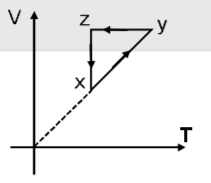Write the relation between pressure and volume for an adiabatic change in an ideal gas.
To derive the relation between pressure and volume for an adiabatic change in an ideal gas, we can follow these steps:
Step 1: Understand the concept of adiabatic process
An adiabatic process is one in which no heat is transferred to or from the system. For an ideal gas undergoing an adiabatic change, the internal energy change is equal to the work done on or by the gas.
Step 2: Use the first law of thermodynamics
The first law of thermodynamics states:
ΔU=Q−W
For an adiabatic process, Q=0, so:
ΔU=−W
Step 3: Relate internal energy to temperature
For an ideal gas, the change in internal energy (ΔU) can be expressed as:
ΔU=nCvΔT
where n is the number of moles, Cv is the molar heat capacity at constant volume, and ΔT is the change in temperature.
Step 4: Relate work done to pressure and volume
The work done (W) on/by the gas during an infinitesimal change in volume is given by:
dW=PdV
Thus, we can write:
ΔU=−PdV
Step 5: Combine the equations
Substituting the expression for work into the first law gives:
nCvΔT=−PdV
Step 6: Use the ideal gas law
From the ideal gas law, we know:
PV=nRT
We can express temperature T in terms of pressure and volume:
T=PVnR
Step 7: Substitute temperature into the internal energy equation
Substituting T into the internal energy equation gives:
ΔU=nCv(P2V2nR−P1V1nR)
This can be simplified to relate changes in pressure and volume.
Step 8: Derive the adiabatic condition
For an adiabatic process, we can derive the relation:
PVγ=constant
where γ=CpCv (the ratio of heat capacities).
Final Relation
Thus, the final relation between pressure and volume for an adiabatic change in an ideal gas is:
PVγ=constant
---
An adiabatic process is one in which no heat is transferred to or from the system. For an ideal gas undergoing an adiabatic change, the internal energy change is equal to the work done on or by the gas.
The first law of thermodynamics states:
ΔU=Q−W
For an adiabatic process, Q=0, so:
ΔU=−W
For an ideal gas, the change in internal energy (ΔU) can be expressed as:
ΔU=nCvΔT
where n is the number of moles, Cv is the molar heat capacity at constant volume, and ΔT is the change in temperature.
The work done (W) on/by the gas during an infinitesimal change in volume is given by:
dW=PdV
Thus, we can write:
ΔU=−PdV
Substituting the expression for work into the first law gives:
nCvΔT=−PdV
From the ideal gas law, we know:
PV=nRT
We can express temperature T in terms of pressure and volume:
T=PVnR
Substituting T into the internal energy equation gives:
ΔU=nCv(P2V2nR−P1V1nR)
This can be simplified to relate changes in pressure and volume.
For an adiabatic process, we can derive the relation:
PVγ=constant
where γ=CpCv (the ratio of heat capacities).
Thus, the final relation between pressure and volume for an adiabatic change in an ideal gas is:
PVγ=constant
Topper's Solved these Questions
- SELF ASSESSMENT PAPER 5BOOK - ICSECHAPTER - SELF ASSESSMENT PAPER 5EXERCISE - Section-B
13 Videos
- SELF ASSESSMENT PAPER 5BOOK - ICSECHAPTER - SELF ASSESSMENT PAPER 5EXERCISE - Section-C
9 Videos
- SELF ASSESSMENT PAPER 4BOOK - ICSECHAPTER - SELF ASSESSMENT PAPER 4EXERCISE - Section-D
6 Videos
- THERMAL CONDUCTIONBOOK - ICSECHAPTER - THERMAL CONDUCTIONEXERCISE - SELECTED PROBLEMS (Taken from the Previous Years ISC, AISSCE, HSSCE various States. Boards Roorke Qns & NCERT text) FROM EXPERIMENT TO DETERMINE K
2 Videos
Similar Questions
Knowledge Check
In an adiabatic expansion of an ideal gas -
A(a) W=−ΔUB(b) W=ΔUC(c) ΔU=0D(d) W=0The relation between internal energy U, pressure P and volume V of a gas in an adiabatic process is
U=a+bPV where a and b are constants. What is the effective value of adiabatic constant γ ?A1. abB2. b+1bC3. a+1aD4. ba
Choose the correct graph between pressure and volume of ideal gas.

View SolutionThe pressure p and volume V of an ideal gas both increase in a process.
View SolutionThe pressure P and volume V of an ideal gas both decreases in a process.
View SolutionA rigid diatomic ideal gas undergoes an adiabatic process at room temperature .The relation between temperature and volume for this process in TVx= constant ,then x is :
View SolutionA rigid diatomic ideal gas undergoes an adiabatic process at room temperature .The relation between temperature and volume for this process in TVx= constant ,then x is :
View SolutionFor a monoatomic ideal gas undergoing an adiabatic change, the relation between temperature and volume TVx = constant, where x is
View Solution
